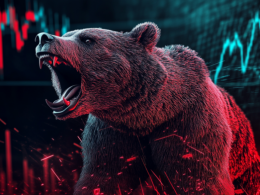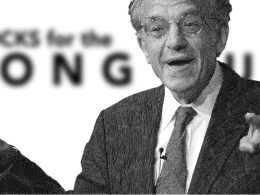by Liz Ann Sonders, Chief Investment Strategist, & Kevin Gordon, Charles Schwab & Company Ltd.
A return to the Great Moderation Era looks unlikely, which might lead to an increasingly volatile—and somewhat unfamiliar—inflationary, economic, and geopolitical landscape.
Let's widen the lens and ponder the possible transition we're in the midst of, to perhaps a different secular environment. The secular era that preceded the pandemic is often referred to as the Great Moderation; one during which disinflation reigned, economic volatility was subdued—save for the global financial crisis—and there was a steady tailwind associated with the epic decline in interest rates.
The Great Moderation era doesn't have an official start point, but in general it's seen as kicking in during the 1990s, although some references date as far back as the early 1980s. The era was punctuated by a number of key characteristics in addition to low economic volatility and disinflation; including longer economic cycles with less frequent recessions, a Fed quick to press the easy policy button all the way to zero, profits representing an outsized share of gross domestic product (GDP), and a positive correlation between bond yields and stock prices.
The era that preceded the Great Moderation and started in the mid-1960s—which we've been calling the Temperamental era—had a very different set of characteristics. They included heightened economic volatility with more frequent recessions (but sharper expansions), as well as greater inflation and geopolitical volatility. It was also an era when labor, via wages, represented a much larger share of GDP relative to profits, and when there was a consistent negative correlation between bond yields and stock prices.
Two very different secular eras

Source: Charles Schwab. For illustrative purposes only.
Economic volatility comparison

Source: Charles Schwab, Bloomberg, as of 6/30/2023.
Moving on to inflation, during the Temperamental era, inflation volatility was on a tear—punctuated by the extreme peaks during the mid-to-late 1970s, as shown below. Those extremes were exacerbated by the Fed's decision on both occasions to declare victory early and ease policy, only to see the inflation genie let out of the bottle again. That led to the insertion of Paul Volker as Fed Chair, who "pulled a Volker" by aggressively raising interest rates to get the inflation genie fully back in the bottle. That directly hit the economy, with the famous double-dip recessions in the early 1980s; but it laid the groundwork for the Great Moderation era to come.
Inflation volatility comparison

Source: Charles Schwab, Bloomberg, Bureau of Labor Statistics, as of 8/31/2023.
Disinflation during the Great Moderation was aided by a number of forces that were "GEL'ing." We've been using the GEL acronym in reference to the abundant and cheap access to Goods, Energy and Labor; courtesy of globalization, the U.S. energy boom and China ascendence into the World Trade Organization (WTO) in 2001. For the most part, all three of those ships are sailing.
Labor power ascending?
The switch was initially flipped due to the severity of the profits recession as the tech bust was unfolding. Profits took a hit again during the financial crisis, but since then have been in a range near record highs as a share of GDP. Conversely, even with the brief spike during the pandemic, labor's share of GDP hasn't picked up to where it was a few decades ago. Yet, another convergence has begun, and this is key to watch to get a sense of whether we are transitioning into an era that might look more "temperamental."
Labor vs. profits

Source: Charles Schwab, Bloomberg, as of 6/30/2023.
Demographics
An aging world

Source: Charles Schwab, United Nations, World Population Prospects (2022).
The age dependency ratio is the sum of the young population (under age 15) and elderly population (age 65 and over) relative to the working-age population (ages 15 to 64). Data are shown as the number of dependents per 100 working-age population. Projections to 2100 are based on the UN's medium population scenario. Forecasts contained herein are for illustrative purposes only, may be based upon proprietary research and are developed through analysis of historical public data.
Bye bye, neoliberalism?
In a recent report, the brilliant macro folks at TS Lombard took on the subject, titling the missive with "A Big Shift Everyone Would Rather Ignore." In it, they posit that "all the basic tenets of neoliberalism are under attack. Governments everywhere are running massive deficits (even at full employment), globalization is retreating, and public officials have even tried their hand at 'price controls' in a desperate attempt to contain the cost-of-living crisis. Yet it is the sudden popularity of industrial policy that takes the attack on a new neoliberalism to new extremes. What this means is deliberate attempts by governments to reshape the economy according to their own strategic ideas. Twenty years ago, such interventions were unthinkable. Today they are becoming the new normal."
There is no question we are seeing profound geopolitical shifts internationally, with the re-emergence of big geostrategic power rivalries (e.g., China vs. the United States and NATO vs. Russia). Perhaps it's wishful thinking, but we find ourselves—at least at this stage in the possible shift—in agreement with TS Lombard's less-pessimistic perspective. The more optimistic view is that "this new era won't be as bad as most assume, especially after a decade in which most economies seriously underperformed." The exclamation point on this view is that "you would have to be extremely myopic to think interest rates at 800-year lows were a 'good' thing, especially given the increasingly toxic political environment they were producing."
Investment landscape considerations
That was followed by a choppy transition around the bursting of the tech bubble; but from that point until the pandemic, the correlation was mostly positive other than during the height of the financial crisis. The explanation for this was, for the most part, disinflation. When yields were rising during this era, it was typically reflective of improving economic growth without an attendant inflation problem—a great environment for stocks. The opposite was the case when yields were falling.
Yields vs. stocks comparison

Source: Charles Schwab, Bloomberg, as of 9/15/2023.
Correlation is a statistical measure of how two investments have historically moved in relation to each other, and ranges from -1 to +1. A correlation of 1 indicates a perfect positive correlation, while a correlation of -1 indicates a perfect negative correlation. A correlation of zero means the assets are not correlated. Past performance is no guarantee of future results.
In sum
Copyright © Charles Schwab & Company Ltd.c











